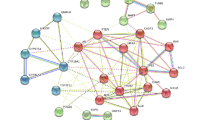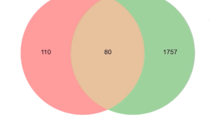Abstract
Globally, the prevalence of prostate cancer is only the second to lung cancer. In Africa however, the commonest cancer among men is cancer of the prostate. The use of natural compounds from plants such as quercetin is being explored as a potential cure. Quercetin is a plant-based flavonoid that has anti-inflammatory, antioxidant and anticancer properties. Although quercetin has been extensively studied, its chemo preventive mode of action is not well-understood. The molecular targets and potential mechanisms underlying the action of quercetin against prostate cancer were identified and validated using network pharmacology and molecular docking methods. The biological targets of quercetin and targets associated with prostate cancer were obtained through database mining. Overlapping targets associated with quercetin and prostate cancer were identified and used to construct a compound–disease target (C-D) network and the targets were subjected to Kyoto Encyclopedia of Genes and Genomes (KEGG) pathway and protein–protein interaction analysis (PPI). A disease target- pathway network was constructed and then merged with C-D network to form a compound–disease_target–pathway (C-D-P) network. Hub targets were obtained from the C-D-P and PPI networks. The binding affinities between quercetin and the retrieved hub targets were identified. Pathway enrichment analysis showed that prostate cancer associated quercetin targets were mainly linked with pathways such as the cancer signaling pathways (HIF-1 and ErbB) and hepatitis B. Basing on the PPI and C-D-P network analysis STAT3, TP53, MAPK1, MAPK3 and KRAS were identified as the main targets and were subjected to molecular docking. The results showed quercetin’s ability to stably bind to the key targets. In conclusion, this study showed the potential molecular targets and mode of action of quercetin in prostate cancer treatment. This can potentially inform the future use of quercetin in the treatment of prostate cancer.






Similar content being viewed by others
Data availability
Data are available upon request from the authors.
References
Alvarez JV, Frank D (2004) Genome-wide analysis of STAT targetgenes: elucidating the mechanism of STAT-mediatedoncogenesis. Cancer Biol 3:1045–1050
Anywar G, Namukobe J (2020) Chapter 2 - Factors affecting the choice for plant-based products in drug discoveries. In: Phytochemicals as lead compounds for new drug discovery. Elsevier, p 15–24.https://doi.org/10.1016/B978-0-12-817890-4.00002-0
Bhat FA, Sharmila G, Balakrishnan S, Arunkumar R, Elumalai P, Suganya S, Singh PR, Srinivasan N, Arunakaran J (2014) Quercetin reverses EGF-induced epithelial to mesenchymal transition and invasiveness in prostate cancer (PC-3) cell line via EGFR/PI3K/Akt pathway. J Nutr Biochem 25(11):1132–1139
Cho NY, Choi M, Kim BH, Cho YM, Moon KC, Kang GH (2006) BRAF and KRAS mutations in prostatic adenocarcinoma. Int J Cancer 119(8):1858–1862
Chu LW, Ritchey J, Devesa SS, Quraishi SM, Zhang H, Hsing AW (2011) Prostate cancer incidence rates in Africa. Prostate Cancer
Daina A, Michielin O, Zoete V (2017) SwissADME: a free web tool to evaluate pharmacokinetics, drug-likeness and medicinal chemistry friendliness of small molecules. Sci Rep 7(1):42717
DeLano WL (2002) Pymol: An open-source molecular graphics tool. CCP4 Newsl Protein Crystallogr 40(1):82–92
Dibal NI, Garba SH, Jacks TW (2020) Acute toxicity of quercetin from onion skin in mice. Pharm Biomed Res
Ebhohimen IE, Edemhanria L, Awojide S, Onyijen OH, Anywar G (2020) Chapter 3 - Advances in computer-aided drug discovery. In: Phytochemicals as lead compounds for new drug discovery. Elsevier. https://doi.org/10.1016/B978-0-12-817890-4.00003-2
Filippi A, Ciolac O-A, Ganea C, Mocanu M-M (2017) ErbB proteins as molecular target of dietary phytochemicals in malignant diseases. J Oncol
Fleshner N (2005) Defining high-risk prostate cancer: current status. Can J Urol 12(Suppl 1):14–17 (discussion 94-16)
Fridlender M, Kapulnik Y, Koltai H (2015) Plant derived substances with anti-cancer activity: from folklore to practice. Front Plant Sci 6:799
Fridrich D, Teller N, Esselen M, Pahlke G, Marko D (2008) Comparison of delphinidin, quercetin and (–)-epigallocatechin-3-gallate as inhibitors of the EGFR and the ErbB2 receptor phosphorylation. Mol Nutr Food Res 52(7):815–822
Gu Y-Y, Zhang M, Cen H, Wu Y-F, Lu Z, Lu F, Liu X-S, Lan H-Y (2021) Quercetin as a potential treatment for COVID-19-induced acute kidney injury: Based on network pharmacology and molecular docking study. PLoS ONE 16(1):e0245209
Hsieh T, Wu J (2009) Targeting CWR22Rv1 prostate cancer cell proliferation and gene expression by combinations of the phytochemicals EGCG, genistein and quercetin. Anticancer Res 29:4025–4032
Hussain Y, Mirzaei S, Ashrafizadeh M, Zarrabi A, Hushmandi K, Khan H, Daglia M (2021) Quercetin and its nano-scale delivery systems in prostate cancer therapy: paving the way for cancer elimination and reversing chemoresistance. Cancers 13(7):1602
Huynh H, Nguyen TTT, Chan E, Tran E (2003) Inhibition of ErbB-2 and ErbB-3 expression by quercetin prevents transforming growth factor alpha (TGF-α)-and epidermal growth factor (EGF)-induced human PC-3 prostate cancer cell proliferation. Int J Oncol 23(3):821–829
Ivanović V, Rančić M, Arsić B, Pavlović A (2020) Lipinski’s rule of five, famous extensions and famous exceptions. Chemia Naissensis 3(1):171–177
Jemal K (2019) Molecular docking studies of phytochemicals of Allophylus serratus against cyclooxygenase-2 enzyme. bioRxiv 866152
Kim M, Kim YB (2021) Uncovering quercetin’s effects against Influenza A virus using network pharmacology and molecular docking. Processes 9(9):1627
Kumar R, Verma V, Jain A, Jain RK, Gupta MG (2011) Synergistic chemoprotective mechanisms of dietary phytoestrogens in a select combination against prostate cancer. J Nutr Biochem Pharmacol 22:723–731
Lee DH, Lee YJ (2008) Quercetin suppresses hypoxia-induced accumulation of hypoxia-inducible factor-1α (HIF-1α) through inhibiting protein synthesis. J Cell Biochem 105(2):546–553
Li S, Zhang B (2013) Traditional Chinese medicine network pharmacology: theory, methodology and application. Chin J Nat Med 11(2):110–120. https://doi.org/10.1016/s1875-5364(13)60037-0
Michaud-Levesque J, Bousquet-Gagnon N, Béliveau R (2012) Quercetin abrogates IL-6/STAT3 signaling and inhibits glioblastoma cell line growth and migration. Exp Cell Res 318(8):925–935
Mohammed A, Al-Numair KS, Balakrishnan A (2015) Docking studies on the interaction of flavonoids with fat mass and obesity associated protein. Pak J Pharm Sci 28(5)
Munuganti RSN (2015) Identification of novel androgen receptor inhibitors for the treatment of castration resistant prostate cancer
Murakami A, Ashida H, Terao J (2008) Multitargeted cancer prevention by quercetin. Cancer Lett 269(2):315–325
Muthian G, Bright JJ (2004) Quercetin, a flavonoid phytoestrogen, ameliorates experimental allergic encephalomyelitis by blocking IL-12 signaling through JAK-STAT pathway in T lymphocyte. J Clin Immunol 24:542–552
Okuku F, Orem J, Holoya G, De Boer C, Thompson CL, Cooney MM (2016) Prostate cancer burden at the Uganda cancer institute. J Glob Oncol 2(4):181–185
Parkin DM, Bray F, Ferlay J, Jemal A (2014) Cancer in Africa 2012. Cancer Epidemiol Biomarkers Prev 23(6):953–966. https://doi.org/10.1158/1055-9965.epi-14-0281
Samec M, Liskova A, Koklesova L, Mersakova S, Strnadel J, Kajo K, Pec M, Zhai K, Smejkal K, Mirzaei S, Hushmandi K, Ashrafizadeh M, Saso L, Brockmueller A, Shakibaei M, Büsselberg D, Kubatka P (2021) Flavonoids targeting HIF-1: implications on cancer metabolism. Cancers 13(1):130
Shannon P, Markiel A, Ozier O, Baliga NS, Wang JT, Ramage D, Amin N, Schwikowski B, Ideker T (2003) Cytoscape: a software environment for integrated models of biomolecular interaction networks. Genome Res 13(11):2498–2504
Singh SP, Konwar BK (2012) Molecular docking studies of quercetin and its analogues against human inducible nitric oxide synthase. Springerplus 1(1):1–10
von Mering C, Jensen LJ, Snel B, Hooper SD, Krupp M, Foglierini M, Jouffre N, Huynen MA, Bork P (2005) STRING: known and predicted protein-protein associations, integrated and transferred across organisms. Nucleic Acids Res 33(Database issue):D433–D437. https://doi.org/10.1093/nar/gki005
Yang F, Song L, Wang H, Wang J, Xu Z, Xing N (2015) Quercetin in prostate cancer: chemotherapeutic and chemopreventive effects, mechanisms and clinical application potential. Oncol Rep 33(6):2659–2668
Acknowledgements
We acknowledge the support from Dr Gerald Mboowa of the African Center of excellence in Computational Biology and Data Intensive sciences at the Infectious Diseases Institute (IDI), Makerere University, Dr. Ivan Ricardo Vega Valdez of Instituto Politecnico Nacional in Mexico, Professor Imtaiyaz Hassan of the Center for Interdisciplinary research in Basic Sciences, India, Dr. Pradeep Kumar, Miriam Nakabuye, the staff of Queen’s University and Center for Emerging and Neglected diseases at University of California, Berkeley.
Funding
This study did not receive funding from any research body or organisation.
Author information
Authors and Affiliations
Contributions
FK conceptualised and conducted the study under the guidance and supervision of AN and GA. FK wrote the first draft of the manuscript under the guidance of AN and GA. All authors have read and approved the manuscript.
Corresponding author
Ethics declarations
Conflict of interest
The authors declare that the research was conducted in the absence of any commercial or financial relationships that could be construed as a potential conflict of interest.
Additional information
Publisher's Note
Springer Nature remains neutral with regard to jurisdictional claims in published maps and institutional affiliations.
Rights and permissions
Springer Nature or its licensor (e.g. a society or other partner) holds exclusive rights to this article under a publishing agreement with the author(s) or other rightsholder(s); author self-archiving of the accepted manuscript version of this article is solely governed by the terms of such publishing agreement and applicable law.
About this article
Cite this article
Kalungi, F., Nsubuga, A. & Anywar, G. Network analysis and molecular docking studies of quercetin as a potential treatment for prostate cancer. In Silico Pharmacol. 11, 24 (2023). https://doi.org/10.1007/s40203-023-00162-4
Accepted:
Published:
DOI: https://doi.org/10.1007/s40203-023-00162-4




